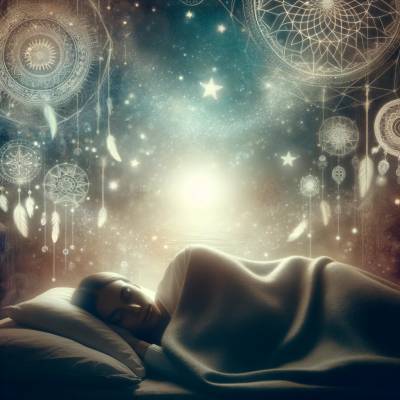Why Do I Dream in Color: A Journey Through the Spectrum of Our Subconscious

Discover the fascinating reasons behind why we dream in color as we delve into the mysterious world of our subconscious. This exploration of colorful dreams will offer insights into the scientific, psychological, and cultural factors that impact our nightly adventures, ultimately revealing the significance of dreaming in color.
I. Introduction
A. The Kaleidoscope of the Subconscious
Delve into the mesmerizing world of colorful dreams, where vivid hues and shades intertwine with the fabric of our subconscious. As we embark on this journey of understanding the reasons behind dreaming in color, we will uncover the fascinating science, psychology, and personal factors that shape our nightly escapades. By exploring the impact of these factors, we can gain a deeper appreciation of the dreamscape and its powerful experiences.
B. Illuminating the Hidden Significance
Dreams have long been a subject of fascination for people from all walks of life. They provide a window into our deepest thoughts, emotions, and desires. But why do we dream in color, and what does it reveal about us? By examining the scientific and psychological aspects of colorful dreams and the unique factors that influence our individual experiences, we can unravel the mystery and embrace the wealth of knowledge our dreams offer. Doing so will better understand our minds and enhance our self-awareness and personal growth.
II. The Science Behind Colorful Dreams
A. Decoding the Neural Rainbow
1. The Tapestry of Sleep Stages
Sleep is a complex process, divided into several stages, including rapid eye movement (REM) and non-rapid eye movement (NREM) sleep. While dreams can occur during any stage, the most vivid and colorful dreams are typically experienced during REM sleep. During this stage, brain activity is similar to the waking state, allowing for the generation of detailed, colorful dreamscapes.
2. Unraveling the Brain’s Color Palette
The brain regions responsible for color perception and processing are mainly the primary visual cortex (V1) and the higher-level visual areas, such as the fusiform gyrus. Research suggests that these areas are active during REM sleep, enabling the creation of dreams with rich color content. However, the exact mechanisms behind the generation of color in dreams still need to be fully understood and require further investigation.
B. The Chromatic Echoes of Memory
1. The Emotional Spectrum
Colors can evoke powerful emotions, and studies have found that the colors experienced in dreams often correlate with an individual’s emotional state. For example, positive emotions may be associated with brighter colors, while negative emotions may manifest as darker or muted hues. This relationship suggests that the colors we dream of may provide valuable insights into our emotional well-being.
2. Life’s Colorful Impressions
Our personal experiences and memories also play a significant role in shaping the colors of our dreams. For instance, someone who recently visited a vibrant, colorful place may experience dreams with similar hues. Moreover, our cultural background and the symbolism associated with specific colors can influence the colors that appear in our dreams, further emphasizing the importance of understanding the connection between our waking lives and our dream worlds.
III. Psychological Aspects of Chromatic Dreams
A. The Language of Colors in Dreams
1. Cultural Color Codes
The symbolism of colors in dreams varies across cultures, with different societies attributing unique meanings to specific hues. For example, in Western cultures, white is often associated with purity and innocence, while in Eastern cultures, it may symbolize mourning or death. By understanding the cultural associations of colors, we can interpret our dreams’ messages more accurately.
2. The Personal Palette
Beyond cultural associations, the colors in our dreams may hold personal significance based on our unique experiences and beliefs. Interpreting the symbolism of colors in our dreams requires self-reflection and understanding our individual associations with specific hues. This reflective process can provide valuable insights into our emotions, thoughts, and desires, enriching our understanding of ourselves.
B. Emotions and the Vivid Dreamscape
1. The Emotional Canvas
Our emotional state plays a crucial role in shaping the content and vividness of our dreams. Our dreams become more vivid and colorful when we experience intense emotions like love, fear, or anxiety. This suggests that paying attention to the colors and emotions experienced in our dreams can offer a deeper understanding of our emotional landscape.
2. The Impact of Stress and Trauma
Stress and trauma can significantly influence the content and intensity of our dreams. In times of distress, our dreams may become more vivid, with an increased likelihood of experiencing nightmares or disturbing content. The colors in these dreams may be darker or more intense, reflecting the emotional turmoil experienced during such challenging times. Recognizing the link between stress, trauma, and colorful dreams can help us identify and address unresolved emotional issues, promoting healing and personal growth.
IV. Factors Influencing Colorful Dream Experiences
A. The Colors of Life’s Journey
1. A Child’s World of Wonder
Children’s dreams tend to be more vivid and colorful than those of adults. This is partly because children have richer imaginations and are more open to incredible experiences. Children’s brains also develop, allowing for increased neural connections and a heightened ability to perceive and process color information during dreams.
2. The Evolution of Dream Hues
As we age, our color perception and the content of our dreams may change. Some studies suggest that older adults may experience fewer vivid, colorful dreams than younger individuals. This could be due to a decline in cognitive function or a decrease in the production of certain neurotransmitters responsible for color perception and vivid dream experiences.
B. The Impact of Visual Media on Dream Landscapes
1. The Silver Screen’s Influence
Exposure to visual media, such as television, movies, and art, can significantly impact the content and colors of our dreams. The images and colors we see in these media forms can become embedded in our memories, later resurfacing in our dreams as vivid, colorful scenes. This suggests that the world may influence the dream experiences we create through our consumption of visual media.
2. The Virtual Realm’s Reverberations
As technology advances, new forms of visual media, such as virtual reality (VR) and video games, have the potential to reshape our dream experiences. Immersive VR experiences and video games can create vivid, lifelike memories, manifesting as colorful, detailed dreamscapes. This highlights the interplay between technology, media, and our dream experiences.
V. Enhancing Dream Experiences
A. Mastering the Art of Dream Exploration
1. Journeying Through the Dream Journal
Maintaining a dream journal is one of the most effective techniques for enhancing dream recall and lucid dreaming. Recording our dreams as soon as we wake up can strengthen our memory and help us better understand the themes, emotions, and colors that permeate our dreams. This practice can also help us identify patterns and triggers for lucid dreaming.
2. The Power of Mindfulness and Meditation
Incorporating mindfulness and meditation practices into our daily routines can improve our ability to recall and control our dreams. These practices help develop greater self-awareness and focus, enabling us to become more conscious of our dream experiences and potentially increasing our capacity for lucid dreaming.
B. The Foundation of a Healthy Dream Life
1. The Pillars of Restful Sleep
Quality and quantity of sleep are crucial factors in determining the vividness and content of our dreams. Ensuring enough rest and a consistent sleep schedule can promote vivid, colorful dreams and improve overall dream recall. Proper sleep hygiene, such as creating a comfortable sleep environment and avoiding screens before bedtime, can enhance our dream experiences.
2. Nourishing the Mind and Body
Our diet, exercise habits, and mental health all play a role in shaping our dream experiences. Consuming a balanced diet, engaging in regular physical activity, and managing stress can improve sleep quality and lead to more vivid, colorful dreams. By prioritizing our overall well-being, we can create optimal conditions for exploring and learning from our dreamscapes.
FAQs
Q: Why do some people dream in color while others do not?
A: The reasons for dreaming in color can vary between individuals and may depend on factors such as brain activity during sleep, personal experiences, emotional states, and exposure to visual media. Some people may have more vivid, colorful dreams due to these factors, while others might experience less colorful or black-and-white dreams.
Q: Does dreaming in color have any psychological significance?
A: Yes, the colors experienced in dreams can hold psychological significance. Colors often represent emotions or symbolize certain aspects of our lives and can provide insights into our emotional well-being, thoughts, and desires. Analyzing the colors in our dreams can offer a deeper understanding of our subconscious mind.
Q: Can I influence the colors I dream in?
A: You can influence the colors of your dreams by exposing yourself to more colorful experiences and visual media or by focusing on specific colors before sleep. However, it is important to note that dreaming in color is a complex process, and many factors can contribute to the hues experienced in dreams.
Q: Do the colors in dreams have universal meanings?
A: While there are some common color associations across cultures, the symbolism of colors in dreams can vary significantly between individuals and societies. Interpreting the meaning of colors in your dreams requires understanding your personal experiences, cultural background, and individual associations with specific hues.
Q: Can stress or trauma affects the colors in my dreams?
A: Yes, stress and trauma can significantly influence the content and intensity of your dreams, including the colors experienced. In times of distress, dreams may become more vivid, and the colors may be darker or more intense, reflecting the emotional turmoil you are experiencing.
Q: Can practicing lucid dreaming help me control the colors in my dreams?
A: Lucid dreaming, the ability to become aware and potentially control your dreams while dreaming, may enable you to influence the colors in your dreams to some degree. However, mastering lucid dreaming can be challenging and requires practice, such as maintaining a dream journal and practicing mindfulness or meditation.
Q: How does age affect the colors experienced in dreams?
A: Age can play a role in the colors experienced in dreams. Children tend to have more vivid, colorful dreams than adults due to their developing brains, richer imaginations, and more open-mindedness. As we age, our color perception and the content of our dreams may change, with some studies suggesting that older adults may experience fewer vivid, colorful dreams than younger individuals.
Conclusion
A. Unraveling the Mystery of Chromatic Dreams
Understanding why we dream in color is a captivating journey that offers a deeper appreciation of our subconscious experiences. By exploring the scientific, psychological, and personal factors contributing to our colorful dreams, we can gain valuable insights into our emotions, thoughts, and desires.
B. Embracing the Spectrum of Our Dream World
We can enhance our self-awareness and personal growth by embracing and learning from our colorful dreams. By paying attention to the colors, symbols, and emotions experienced in our dreams, we can better understand our inner selves and navigate the complexities of our daily lives.
Suggested Readings
Embark on a journey to unravel the mysteries of colorful dreams with these suggested readings. Each resource offers a unique perspective on the captivating world of chromatic dreams, providing insights into the scientific, psychological, and personal factors that shape our subconscious experiences. Delve into these fascinating works and uncover why we dream in color.
- “The Dreamer’s Palette: A Guide to Understanding Why We Dream in Color” – This comprehensive guide explores the science, psychology, and symbolism behind our colorful dreams, offering readers a deeper understanding of their subconscious experiences.
- “Colorful Dreams: A Journey Through the Subconscious” – This intriguing book delves into vivid dreams, highlighting the factors contributing to their colorful nature and providing valuable insights into our inner selves.
- “The Spectrum of the Subconscious: Why We Dream in Color” – This fascinating work investigates the neurological and psychological aspects of colorful dreams, examining the role of brain activity, emotions, and personal experiences in shaping our dreamscapes.
- “Dreams in Technicolor: A Comprehensive Exploration of Chromatic Dreams” – This insightful book takes readers through the various factors that influence our dreams, from cultural symbolism to individual memories, providing a well-rounded understanding of why we dream in color.
- “The Art of Dreaming in Color: A Guide to Unlocking the Secrets of Vivid Dreams” – This captivating resource examines the rich tapestry of our dream world, revealing the complex interplay between our waking lives and the colorful dreams that fill our nights.
By exploring these insightful resources, you will understand the complex world of colorful dreams and uncover the factors contributing to our vivid subconscious experiences. Let these works inspire you to reflect on your dream experiences and embrace the beauty of your dreamscapes.






